人教版高中英语必修4A taste of English Humor说课稿3篇
-
- 页数:10页
- 字数:约 18157 字
- 大小:146.50KB
- 格式:.doc
- 版本:Office2016及以上版本
- 作者:Vincent演示
A taste of English Humor说课稿3篇
必修四unit3说课稿一
Unit 3 Book 4
A taste of English Humor
Part one : Understanding of the lesson
本课选自人民教育出版社出版的普通高中课程标准实验教材,高一年级必修四的第三单元A taste of English humour。

A. The analysis of the teaching material
The purpose of this reading is tointroduce the life and work of Charlie Chaplin and the kind of humour we canall laugh at --- nonverbal humour.
This lesson is designed as a readinglesson. According to the new curriculum
standards of senior high school English,students are expected to achieve the skills of a. understanding the main idea;b. scanning for the needed information; c. grasping the details; d. guessingthe meaning of new words; e. understanding the intension and attitude of theauthor and f. understanding the background and culture information.
B. Teaching Aims:
a. Enable students to learn what humormeans and what is nonverbal humor.
b. Students are expected to improve thereading skills, ie, skimming and scanning skills as well as translating ,interpreting and word guessing abilities, which are examined in recent years inNMET.
By learning the passage, students willknow that humour is particular to each culture. So the English humour iscertainly different from Chinese humour. However , there is a kind of humourthat may be enjoyed by all cultures --- that is nonverbal humour. It is goodthat we can all laugh at something together.
a. self-learning and cooperative learningmethods; and use such kind of ability to gain and deal with languageinformation.
b. develop the students’ questioning spirit to improve theirability of finding,
analyzing and solving problems.
C. Teaching methods:
a. Task-based Language Teaching :
During the course, different tasks aredesigned for Ss to carry out. Whether and how they finish the tasks can reflecton how much information they grasp from reading. In return, the teacher canadjust his/her teaching.
b. Cooperative Learning:
Divide the class into small teams, eachwith students of different levels of ability.
Every member of a team is responsible notonly for learning what is taught but also for helping teammates learn, thuscreating an atmosphere of achievement.
D. Important and difficult points.
a. Help students learn how to understandand enjoy English humors.
b. Help students know the differencesbetween English and Chinese in humor.
E. Teaching aids:
Multi-media
pictures
blackboard
Part Two:Teaching procedures:
Step one: Lead-in and Warming up( 5 mins)
In order for students to get into thetopic of humor quickly and smoothly, a piece
of sketch video “Eating noodles”by Chen Peisi will be played for thestudents.
Question: Do you know who the Chinesecomedian is ?( Chen Peisi)
What makes his performance funny? ( hisbody gestures)
Then show some pictures of Charlie Chaplinto students.
Questions: Do you know who he is ?
What do you know about Charle Chaplin?
What do you expect to learn about fromthis reading? ( students’ answers
may vary)
(简评:这一环节的设计将会激发学生对文章中这一话题的兴趣并能引起让学生
在短时间内集中精力,这对于学生完成下面的阅读任务很有帮助。)
Step Two: Reading ( 22 mins)
Fast Reading ( Skimming) (7 mins)
Task 1: Fast Reading (3 mins)
What’s the passage mainly about?
C. Because he is always made fun of byothers.
D. Because of his optimism anddetermination fo overcome all difficulties.
3. Find a sentence in the passage similarin meaning to the following one:
Charlie’s real life was not so comfortable as itwas showed in his films.
4. Translate the sentence into Chinese “You may find it astonishing that Charliewas taught to sing as soon as he could speak and dance as soon as he could walk”. 5. Guess the meaning of the word “convincing” in line 30 Page 18.
(简评:这一环节沿用了英语阅读教学中最重要的两种阅读技能,即略读和查读。这也是本课设计的重点。同时,在查读这一环节的任务2中,我设计了高考新题型的相关练习,如翻译,替换句子等等,这样就有效地把高考和日常教学联系了起来,也促进了学生应答这种练习的能力。)
Step Three : Retelling (5 mins)
People may laugh at others_______ on abanana skin, or falling down a hole, for it makes them _______ with themselvesseeing others _______ _______ than
themselves.
As an outstanding humourous actor, Chaplincould always _______ in the people deep feelings by using _________ forms ofacting in the time of silent films. His charming _________ “the little tramp” is well-known all over the world, a poorand _________ person wearing large trousers, ________ shoes, and carrying awalking _______.
A social _______ as he was, he was lovedby all the people for his ____________ in overcoming difficulties and beingkind to people _______ to him. When playing the famous film The Gold Rush,Chaplin managed to make the sad situation—eating a _______ shoe, entertaining byusing __________ humour.
Such is Charlie Chaplin who produced,_______ , and wrote the movies that he _______ in. He was given a special Oscarfor his lifetime work ____________ of bringing humour to us all.
(简评:这一环节是一巩固练习,使得学生对文章中的既得信息有所加强,并对这篇文章有了更加整体的理解。)
Step Four: Pair work. ( Enjoying 4 mins)
Part 1:
JOKE 1
Wife talking to her husband (who readsnewspaper all day): I wish I were a
newspaper so Ill be in your hands allday.
Husband: I wish that too, so I couldchange you daily
JOKE 2
TOMS EXCUSE
Teacher: Tom, why are you late for schoolevery day?
Tom: Every time I come to the corner, asign says, "School-Go Slow".
Part 2:
Show the students some pictures ofnonverbal homour to let them
appreciate . (omitted)
Step Five : Interview ( Group activity8mins)
The students are divided into groups of 4. Then in each group students will take their turns to be Charlie and the other3 act as reporters to interview him/her using the information from the reading.
(简评:这两个环节是为了知识转化/过渡, 即让学生切实体会到nonverbal
humour is really universal, 又给了学生练习口语的机会,同时也体现了本课时的情感目的。)
Step Six : Home work
Find more information about Chaplinthrough The Internet or from books and you are expected to present it to yourclassmates in the next class.
(简评:这是这节课的综合落实环节)
课后反思:
本节课主要训练阅读技能,兼顾听、说和译等技能的培养。在具体实施过程中采用了任务型教学法,体现了因材施教原则和以学生为主体的教学原则,通过师生的共同努力与配合,圆满完成了教学任务,提高了学生的阅读能力,同时通过小组讨论,增强了学生的合作意识。此期间也出现了一些问题,如内容太多,时间仓促,致使个别环节处理非常不太恰当,用时太少,而没有完全达到预期的效果。另外,在上课中有时让学生按部就班地跟着老师的思路走,而忽视了他们的主体地位和主观能动性,从而限制了学生的思维。另外,学生的学习积极性还没有完全调动起来,这一点也是以后的教学中需要特别注意的。总之,教与学两个环节中,应把重点放在学生身上,老师的教是为学生的学服务的。
必修四unit3说课稿二
Unit3 A taste of English humor
一、说教材
1、说教材的地位和作用
我这节课的内容是人教版高中英语必修四第三单元A taste of English humor的Warming-up和Reading部分。本单元是关于不同类别的英式幽默,通过学习本单元,能够让学生了解Charlie Chaplin滑稽但是却鼓舞人心的幽默,This reading material tells us the storyabout the master of nonverbal humor, Chalie Chaplin, including his life story,his achievements in film making, and his great performance in Gold Rush.本单元阅读部分不但能让学生了解到关于Charlie Chaplin的相关信息,同时也能够让学生通过本篇课文,提高英语学习的能力。
The central topic of this unit is “humor”. Humor has two meanings. Firstly, itrefers to the quality in something that makes it funny and makes people laugh.Secondly, it refers to the ability to think that things are funny, or funny thingsyou say that show you have this ability. Through the study of this unit, theteacher will let the students realize that there are many different ways tounderstand and express humor because of cultural difference, and this maysometimes cause misunderstandings. What is more, it is hoped that the studentscan get an optimistic attitude towards life after learning this unit.
2、教学目标
众所周知,阅读在英语学习的过程中属于语言的输入过程,而语言的输入过程又对语言的输出过程,比如说和写又有很大的作用,那么,在研究完新课程标准和教学大纲后,我的教学目标将会是知识目标、能力目标、情感目标。
(1)知识目标学生能够听懂,读懂,并且能够正确地使用文中重点的单词,短语重点单词:humor content astonishing unfortunatelyordinary bored entertain throughout homeless worn failure overcome leather chewconvince convincing direct outstanding 重点短语:up to now, badly off, pick out, cut off,star in 学生能够理解文章的内容。
(2)能力目标增强学生的听,说,读,写能力,尤其是说和写的能力训练学生共同协作的能力增强学生阅读能力,尤其是跳读和精读的能力。
(3)情感目标通过本文,学生能够从Charlie Chaplin那学到乐观面对生活的苦难,并且能够自己去发掘我们生活中的幽默。Enable the students to learn what humormeans and what is nonverbal humor. Help students to learn the Subjunctive Mood.
3、教学重点和难点
重点:帮助学生了解重点单词及短语的用法,提高学生的阅读能力。难点:帮助学生理解中式和英式幽默的区别。
二、说学情
高中年级的学生已经在初中阶段的英语学习中,已经积累了一定的词汇基础,并掌握了一些简单的学习策略和技巧,具有初步的英语听说读写能力。但是,学生个性和英语水平差异大,因此教学设计要有梯度,由浅入深,注意层次性。
英语作为一门语言,其最基本的作用就是人际交流。这个阶段的学生思维非常敏捷,并且他们也非常渴望展示自己,而他们自身也存在着一定的阅读能力,但是他们缺少相应的外国文化背景以及表达自己思想的勇气,因此我在课堂要鼓励学生们搜集资料了解外国文化同时利用每个机会开口说英语,以达到锻炼口语的目的。
三、说教法和学法
1.教法:①任务教学法:结合学生的生活经验和兴趣设计相当的任务值,让学生在完成任务的过程中学习到应有的知识并提高语言的沟通能力。同时让学生带着问题去阅读,找出相关答案,并分析整理形成自己的观点。
②情景教学法:通过举例以及观看相关视频和图片让学生了解以卓别林为代表的英式幽默和中式幽默的区别并谈谈自己的感受。
2.学法:虽然这个阶段的学生具有一定的阅读能力,但是由于文化差异,学生可能难以理解外国式的幽默,所以老师可以引导学生在原有的知识经验基础上通过合作探究学习构建新的知识经验和信息输入。
四、说教学过程
Step I: Lead-in and Warming up (5 mins)
Firstly, the students will be asked toread the two jokes on Page 17. 问学生课文17页的笑话。Then, the teacher will guide the studentsto get farmiliar with different types of English humor by the chart.然后引导学生进一步了解英式幽默。
Next, the students are encouraged to thinkabout the other types of humor and the types of Chinese humor. (sketch, crosstalk, funny stories and so on)鼓励学生说出自己指导的一些有趣的中文和英文幽默故事来比较两者的区别。
设计意图:用问题的方式引入本节课的话题,引发学生思考。
Step II: Pre-reading (5 mins)
The teacher will show the students somepictures of Charlie Chaplin. And then let the students to say anything theyknow about him. 我会给学生展示卓别林的相关图片,然后让学生说出他们对卓别林的了解。Let the students see the title of thereading material and ask them to guess what the text is about. 让学生根据课文的题目先预测课文的内容。
设计意图:引起学生的兴趣,激发他们阅读的兴趣和欲望。
Step III: Fast reading (5 mins)
Ask the students to read the text quicklyin three minutes and then finish Exercise 1 on Page 19. 让学生进行三分中快速阅读和完成课文19页的题目。
设计意图:这一环节沿用了英语阅读教学中重要的阅读技能之一,即快速阅读。可以让学生对课文有一个大致的了解。
Step IV: Explanation (10 mins)
The teacher will explain the importantlanguage points in the text. 解释课文中出现的重点词汇和知识点。Then the students will be asked to work ingroups to summarize the main idea of each paragraph. (Exercise 2 on Page 19)让学生分组进行总结归纳文章的段落内容。
设计意图:让学生掌握课文中的重点词汇和句子,加深对课文的理解。 Step V: Listening and Discussion (10mins)
Listen to the tape of the text and then ingroup, ask the students to have a discussion about Charlie Chaplin。让学生听一遍全文,展开有关卓别林的讨论。
1. Do you think his poor childhood helpedhim in his work? Why? 你认为艰苦的童年是否对卓别林的成功有帮助?为什么这么认为?
2. Why do you think he was so successful? 你认为卓别林成功的原因是什么?
3. What can we learn from him? 从卓别林身上可以学到什么?
设计意图:用问题的方式加深学生对阅读内容的理解,同时可以很好的锻炼学生的口语表达能力。
Step VI: Interview and Homework ( Groupactivity) (10 mins)
The students are divided into groups of 4. Then in each group students will take their turns to be Charlie and the other3 act as reporters to interview him/her using the information from the reading.
(简评:这两个环节是为了知识转化/过渡, 即让学生切实体会到nonverbal humour is really universal, 又给了学生练习口语的机会,同时也体现了本课时的情感目的。Find more information about Chaplinthrough The Internet or from books and you are expected to present it to yourclassmates in the next class.
(简评:这是这节课的综合落实环节)
五、板书设计
必修四uni3说课稿三
Good morning/afternoon, everyone! Im veryglad to stand here to interpret my lesson. Today my topic is “A taste of English humor” (writing part). I am going to introducemy lesson from the following aspects: the
analysis of teaching material andstudents, teaching aims, teaching key points and different points, teaching andstudying methods, teaching procedures and blackboard design.
Ⅰ. Analysis of the teaching material
First of all, let’s focus on the analysis of teachingmaterial. This unit is about humor in English. Writing part consists of threesections: section 1 is a speaking activity. Actually it has two stages: adiscussion and a story telling. They can used as a preparation for writing.Section 2 includes some guidance for writing and they are in time-order. Thesection 3 has a sample writing and the format for each part.
Ⅱ. Analysis of the students
Then, I’d like to talk something about thestudents. Funny story is a very interesting topic and related to their dailylife. However, many language
learners face a big challenge in writing,especially on the aspect of grammar or logic order, so do my students. Theywill easily get frustrated and bored if teacher doesn’t guide them in a right way.
Ⅲ. Analysis of the teaching aim
Based on the syllabus and the analysis, Iset the teaching aims as follows: Knowledge aims: Students will learn somebasic knowledge about story writing, including its format: the situation, whathappens, and the punchline
Ability aims: Students can develop theirlogical thinking ability through writing and their The ability of creatingfunny stories from their real life can be trained.
Emotional aims: Students can form apositive attitude towards life and the sense of humor. And they could enjoy thesuccess in writing.
Ⅳ. Analysis of the key and difficult points
According to the teaching aims, both thekey point and the difficult points of this lesson are leading students to findsome basic knowledge about story writing, including its format: the situation,what happens, and the punchline.
Ⅴ. Analysis of teaching and study methods
To help students achieve the teaching aimsmuch easier, I will mainly use process writing task-based teaching method,multimedia method and communicative teaching method and so on. For students, Iwill encourage them to learn to communicate with their classmates to let thembecome the real leading role of the class.
Ⅵ. Analysis of the teaching procedures
Pre-writing:
In the beginning, I would tell them thepurpose of this lesson. Then I would tell them a typical funny story and Iwould obverse their reaction when listen to the story.
In fact, that story is very traditionaland some of them would not be interested in it because they heard a lot storieslike that in the recent week. The purpose is make the next stage much easier.
After listening, I would ask them to do adiscussion about what the story: Do they like it, why. And the words andexpressions in the textbook can be used in their discussion.
This speaking activity can lead studentsto think about how to think out a funny story. It is good for their writing.And in the ending period of this unit, we use a speaking activity for warming-upis suitable.
您可能喜欢的文档
查看更多
人教版高中英语必修1English around the world说课稿
- 页数:7页
- |大小:56.89KB

人教版高中英语必修4Women of achievement说课稿4篇
- 页数:10页
- |大小:79.00KB
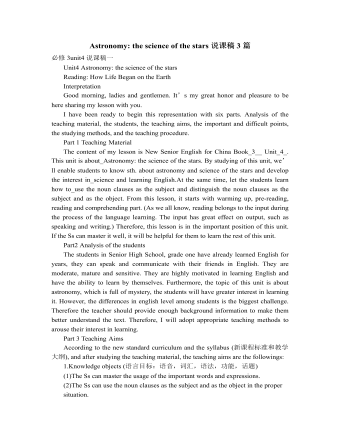
人教版高中英语必修3Astronomy the science of the stars说课稿3篇
- 页数:10页
- |大小:96.50KB
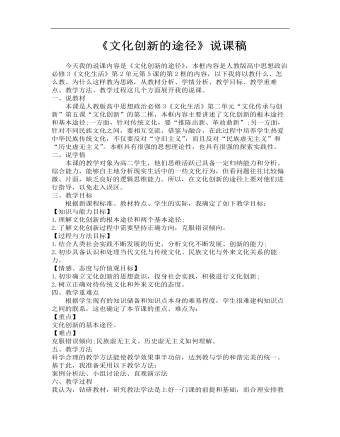
高中思想政治人教版必修三《文化创新的途径》说课稿
- 页数:4页
- |大小:33.63KB

高中思想政治人教版必修一《收入分配与社会公平》说课稿
- 页数:6页
- |大小:49.51KB
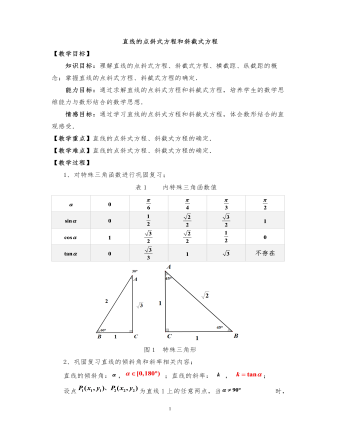
高中数学人教版必修二直线的点斜式方程教案
- 页数:5页
- |大小:253.56KB

高中数学人教版必修二直线的点斜式方程教案
- 页数:5页
- |大小:253.79KB
热门说课稿
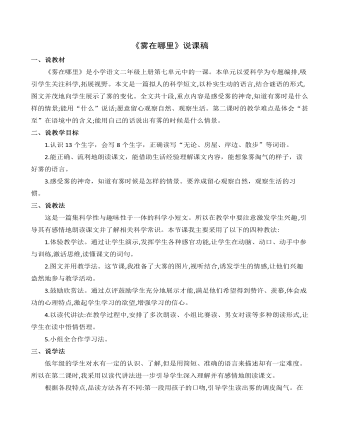
雾在哪里说课稿
- 页数:3页
- |大小:46.00KB
- 说课稿
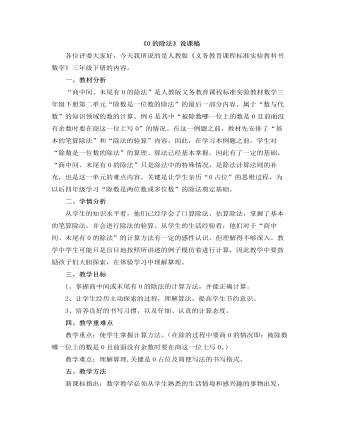
小学数学人教版三年级下册《0的除法》说课稿
- 页数:6页
- |大小:34.92KB
- 说课稿
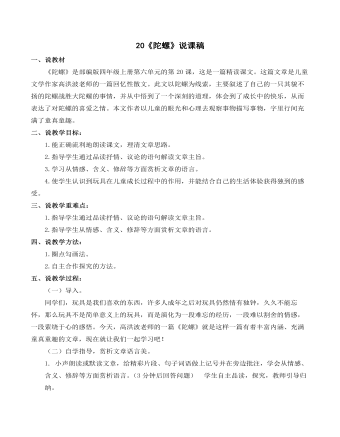
《陀螺》说课稿
- 页数:4页
- |大小:39.00KB
- 说课稿

小班数学说课稿《按规律排序》
- 页数:5页
- |大小:92.24KB
- 说课稿

小学数学人教版一年级上册《认识钟表》说课稿
- 页数:4页
- |大小:24.27KB
- 说课稿

小班生活《小脚找朋友》说课稿
- 页数:2页
- |大小:33.31KB
- 说课稿
今日更新

5月份主题教育工作情况总结汇报
- 页数:3页
- |大小:136.87KB

××县招商局2024年上半年工作总结
- 页数:12页
- |大小:142.54KB

×××公安局机关党委上半年党建工作总结
- 页数:7页
- |大小:186.25KB

《2019—2024年全国党政领导班子建设规划纲要》实施情况的工作总结3800字
- 页数:6页
- |大小:29.16KB

“转观念、勇担当、新征程、创一流”主题教育活动阶段性工作总结
- 页数:3页
- |大小:22.76KB

“四零”承诺服务创建工作总结
- 页数:5页
- |大小:39.83KB





